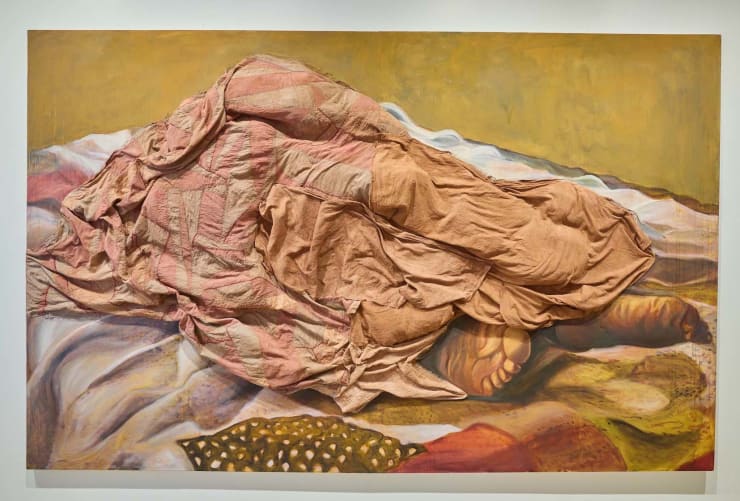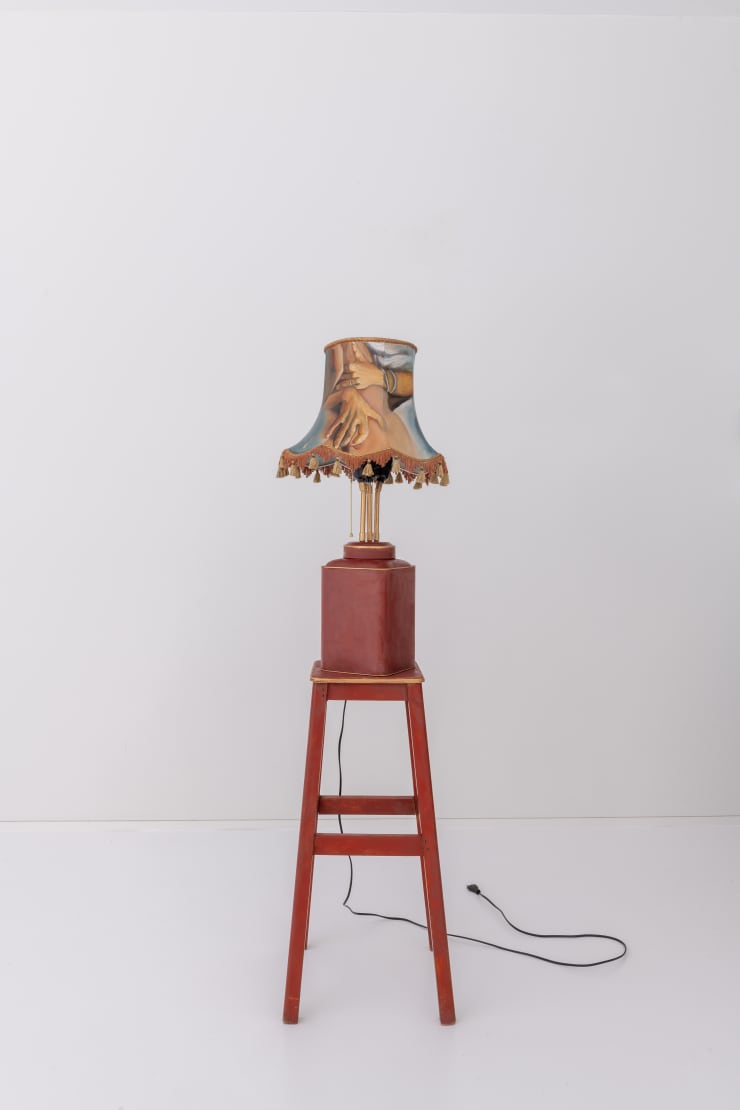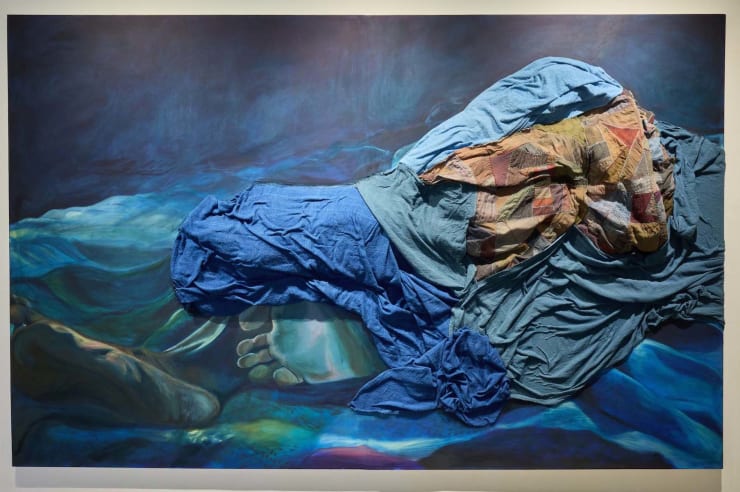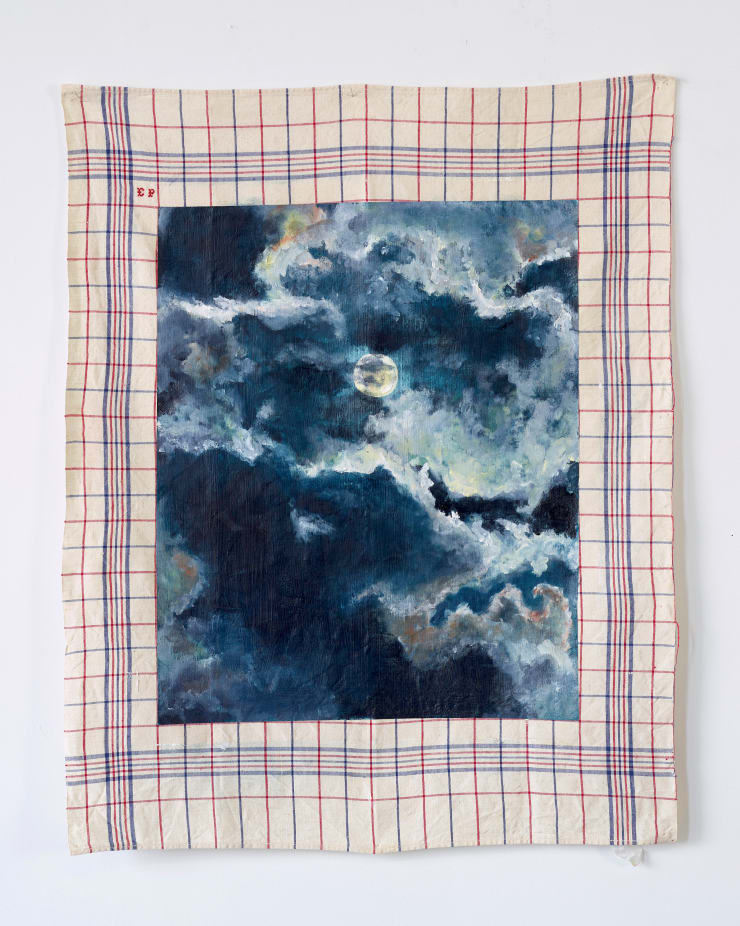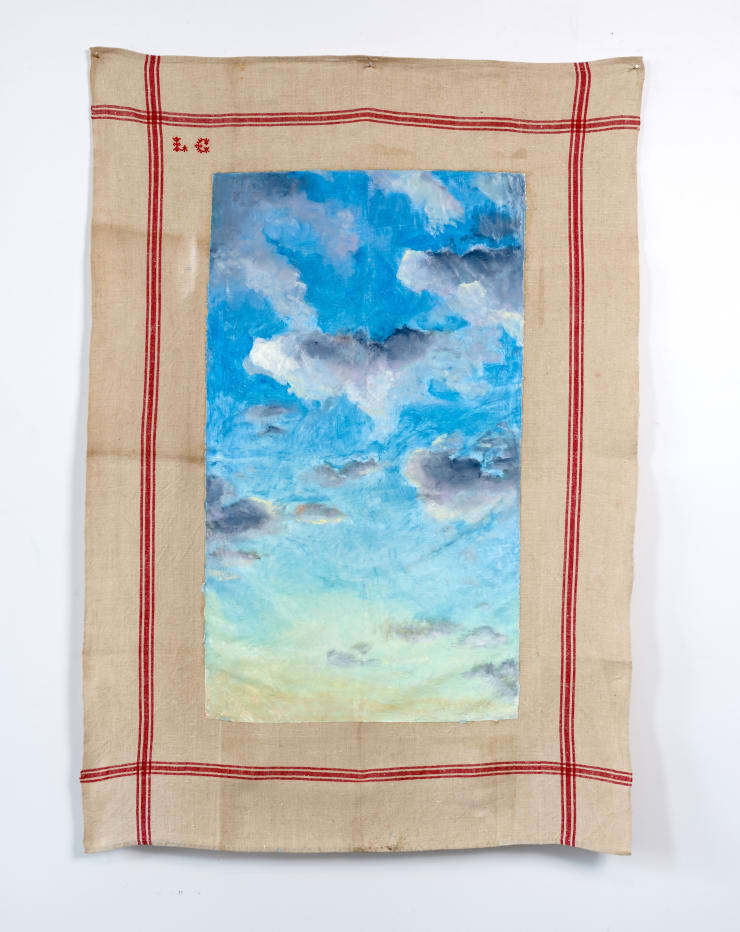-
Experimenter presents کروٹ | करवट | Karvat, Bhasha Chakrabarti’s first solo at Experimenter – Colaba, Mumbai and her second solo at the gallery.
-
Bhasha Chakrabarti’s exhibition, Karvat, derives and extends from Ismat Chughtai’s short story, “Lihaaf”, where two women explore desire in the shadows, comfort, and/or safety of the quilt. The protagonist of the story is Begum Jaan’s young, distant relative, at the threshold of adolescence herself, who witnesses and narrates the strange, recurrent, and seemingly violent phenomenon of the quilt rising, swirling and eventually falling flat, fatigued, in the dark of the night. The hisses, sighs, and rustling moans, with the bodies of Begum Jaan and her lover Rabbu finding states of alignment and friction, demonstrate an unrestricted desire made possible by the malleability of the lihaaf.The quilt in “Lihaaf”, like in Chakrabarti’s practice over the years, becomes a cover for the bareness of bodies and a site of self-determination and pleasure. A quilter, before she was a painter, the artist, extends the carnality of Begum Jaan’s quilt. She approaches it as a landscape, cloud, or turbulent ocean, painted and sometimes collaged. The body—a face or limb—mostly hers and occasionally a lover’s, slips out from under the vastness of the cover. The body is not at rest, but stretched, curling or twisting in search of comfort. In Karvat (صبح)/The Turn (Morning) and Karvat (रात)/The Turn (Night), used fabric is reappropriated to construct the quilt.Chakrabarti’s visual choreographies demand a closer look at the body and its field of movement to produce new structural affinities between sexuality and spatiality. Here, the metaphorical matures into the corporeal, turning suggestions or suggestiveness to hard evidence. In what may seem repetitive, are slight, unique variations that inevitably trick us into seeing new constellations of bodies and spaces.As much as with the body in states of rest and restlessness, Chakrabarti is also concerned with the body in labour and time. She consistently produces raw materials for her making, through foraging, grinding, churning, piecing, and recalibrating. Each of these acts is concerned with attuning the body to mind and muscle memory. These processes allow for chance, room for error and imperfections, failures and surprises. The stress on making with the hand is to imprint with touch.The traditional Japanese method of Kakishibu is employed to make the paper quilt titled Kaghazi Hai Pairahan. The dye made using persimmon juice is curative and in that sense produces a surface of healing and preservation. It is enmeshed with time in its processes of fermentation, and how it continues to deepen and mature over the years. These material gestures that we may not necessarily read in the works or even know of, continue to dwell within Chakrabarti’s practice. That this paper work, is made from pulping and layering Urdu, Hindi, and English translations of Chughtai’s “Lihaaf” marks a literal return to where it all started—like a beast beneath the quilt—present and in pleasure, under the surface, waiting to rise, swirl and swing, collapse maybe, but breathing.
-
-
 Bhasha Chakrabarti, Ajaibghar (Asavari), 2024
Bhasha Chakrabarti, Ajaibghar (Asavari), 2024 -
 Bhasha Chakrabarti, Ajaibghar (Deepak), 2024
Bhasha Chakrabarti, Ajaibghar (Deepak), 2024 -
 Bhasha Chakrabarti, Ajaibghar (Devagandhar), 2024
Bhasha Chakrabarti, Ajaibghar (Devagandhar), 2024 -
 Bhasha Chakrabarti, Ajaibghar (Gaurmalhar), 2024
Bhasha Chakrabarti, Ajaibghar (Gaurmalhar), 2024 -
 Bhasha Chakrabarti, Ajaibghar (Hindol), 2024
Bhasha Chakrabarti, Ajaibghar (Hindol), 2024 -
 Bhasha Chakrabarti, Ajaibghar (Kakubha), 2024
Bhasha Chakrabarti, Ajaibghar (Kakubha), 2024 -
 Bhasha Chakrabarti, Ajaibghar (Meghamalhar), 2024
Bhasha Chakrabarti, Ajaibghar (Meghamalhar), 2024 -
 Bhasha Chakrabarti, Ajaibghar (Sarang), 2024
Bhasha Chakrabarti, Ajaibghar (Sarang), 2024 -
 Bhasha Chakrabarti, Ajaibghar (Todi), 2024
Bhasha Chakrabarti, Ajaibghar (Todi), 2024 -
 Bhasha Chakrabarti, I think resurrections here are sweeter, it may be, than the longer lasting one - for you expect the one, and only hope for the other, 2024
Bhasha Chakrabarti, I think resurrections here are sweeter, it may be, than the longer lasting one - for you expect the one, and only hope for the other, 2024
-
-
Chakrabarti lets the interior spaces, particularly the zenana of the Nawab’s house (Begum Jaan’s domain) spill into the exhibition space. Reimagined as a red room á la Matisse, she loads this milieu with a diversity of references. The Venetian Red, for example, comes from hematite and was used across history from the primal 17,000-year-old cave paintings of Lascaux to the murals of Pompeii. Chakrabarti has been scouring mining waste to mill and extract her own pigments to paint bodies with literal landscape dust. It wouldn’t be a stretch to connect these impulses to the animalesque in Lascaux or scenes of unbounded pleasure in Pompeii or more directly to the Deccani Ragamala paintings in the Indian Museum in Calcutta that she reinterprets in her Ajaibghar series. Furniture is foraged and painted red with golden borders, and imbued with music. Claiming both intimacy and touch, the raga spills out only when you open a drawer or pull a door.The lonely Begum Jaan is no different from the nayikas. In Todi Ragini, the heroine evokes both tenderness and sadness separated from her lover. Lost in a forest, her tunes attract a black buck even as the trees suggestively sway as music. In her interpretation in Ajaibghar (Todi), the time of the day remains suspended in a study of a blue sky with clouds, while two buck candle-stands are perched atop the drawer. In Ajaibghar (Hindol) the two arms of the nayika hold the ropes of a swing across an arrangement of two chairs, suggesting a solo flight. The swinging, is a rhythm unto itself. All these boxes open out to the sky at a time corresponding to the ragas, to suggest freedom with its possibilities. All these images also show the protagonist holding onto herself, another body, or an object—a fleshy grip that extends into a wanton desire.
-

-
In Nephology I, II and III, she draws bedsheets on indigo grounded paper made from old linens—marking a subject onto its past life through silverpoint drawings as though it were both a revision and recollection. Titled as the study of clouds, it opens itself out to an exercise of watching and observing as personal experiences. In her juxtapositions of body, bed, cloud, sky, Chakrabarti allows for wonder to filter in from the expanse of the sky and seep out into the possibilities of intimacy in the bedroom.
-
What occurs when the expected verticality of the awake, aware body is placed in the horizontality of a bed aligned to the ground? When the body is thinking of the absent lover, is it still companionship? What happens when the body becomes the ground, spreading like a landscape, touched and turmoiled by weather, climate, and its own core, the heart?
And then there is the landscape of the sky, in mists and hazes, fog and cloud. Chakrabarti in the Antariksha series paints the sky with oil, on found tea towels. The towels become windows which we see through—to the in-between space between the realms of the earth and the heavens.
-
-
Film: Artist Is Not Present: Bhasha Chakrabarti
Featured Artist: Bhasha Chakrabarti
Direction: Shaikh Ayaz & Dhruvin
DOP: Hemanth Kumar
Editor/CC/Music: Tito+
Camera Operator and Production
Supervisor: Soléne Haquette
Location courtesy: Hampi Art Labs -
Bhasha Chakrabarti (b. 1991; currently lives and works in New Haven, Connecticut) graduated with an MFA in Painting and Printmaking from the Yale School of Art in the Spring of 2022. Chakrabarti has exhibited in solo and group shows at Experimenter (Kolkata), Jeffery Deitch (New York & Los Angeles), Hales (New York), M+B (Los Angeles), Museum of Art and Photography (Bangalore) and Lyles & King (New York). Chakrabarti is the recipient of the South Asia Artist Prize (SAAI) awarded by University of California, Berkeley. She was a semi-finalist in the Smithsonian’s 2022 Outwin-Boochever Portrait Competition and was awarded a Beinecke Research Fellowship in 2021 and the Fountainhead Residency in 2020. Her works have been written about in The New York Times, Hyperallergic, and The Art Newspaper.
Bhasha Chakrabarti | کروٹ | करवट | Karvat
Current viewing_room

